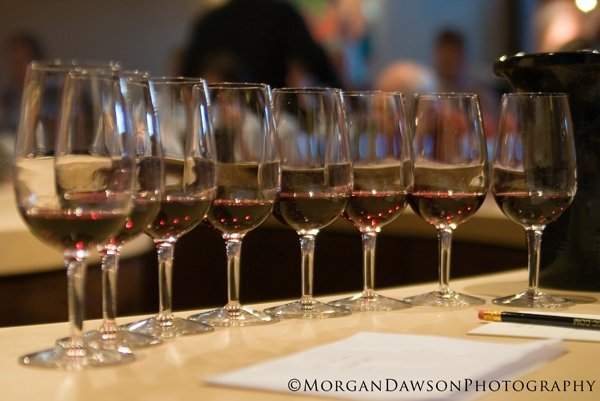
By Evan Dawson, Finger Lakes Editor
Photos by Morgan Dawson
When the demonstration room at the New York Wine & Culinary Center filled up at 10 a.m. on Tuesday morning, 328 glasses of cabernet franc lit up the amphitheater like strands of single-color Christmas lights. It was a bit daunting for the 42 winemakers, winegrowers, industry professionals, newspaper writers, retailers and bloggers.
And that was just the first flight.
When the event (
get some back story) finally ended three hours later we had tasted through 13 Finger Lakes 2007 cabernet francs, 3 Loire Valley cabernet francs, one Long Island cabernet franc, and 5 Finger Lakes 2007 reserve cabernet francs. Wine writer Holly Howell even brought her own gift for the group, a 2002 Loire that was just beautiful.
On this blog and in other forms of media we'll be hearing from retailers — who have to sell the wine — and writers who will share their own ideas. And I'm sure we'll hear from industry professionals. Here are some of my takeaways from an undeniably successful event:
Finger Lakes cabernet franc has a recognizable style.
It was pretty remarkable to see that the participants had no trouble discerning which wines were from the Finger Lakes and which were not. Cabernet franc has a local identity, which is important.
It's not always good, though. Some of the wines gave off odd, citrusy flavors (others referred to this as a persistent sour cherry note), and some of the wines still lacked depth and weight — even from a ripe vintage like 2007. But the best of the group were balanced with bright cherry, black pepper, and grilled herbs, and the very best added layers of mouthfeel that extended the finish of the wine.
The top-scoring wine was the Ravines Wine Cellars 2007 Cabernet Franc, and its appeal was best summarized by Fox Run assistant winemaker Tricia Renshaw. She remarked, before seeing the bottle revealed, "This is a delicious wine with great mouthfeel."
Can it be coincidental that the top-scoring wines were among the lowest-cropped wines? Yes, under-cropping can be an issue, but as one winemaker pointed out during the event, "The lower the yield, the more weight cabernet franc seems to have. You can't get that mouthfeel with over-cropped vines."
One winemaker confessed to me, in confidence, that recently they weren't careful and ended up with 7 tons per acre of cabernet franc. "Not only was the wine not very good, but there was a huge amount of it!" he said.
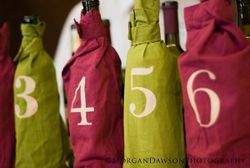 Local winemakers do not seem to enjoy wines from other regions.
Local winemakers do not seem to enjoy wines from other regions.
This statement is a little broad-sweeping and probably a touch unfair, and maybe it will get some backlash, but I can't help it.
The bottom two wines based on score were the 2005 Charles Joguet Chinon (Dioterie cuvee, $36) and the 2005 Domaine des Vallettes Bourgueil ($12). The other non-FL wine, the Shinn Estate Vineyards 2007(Long Island), finished in the bottom half of the scoring pack.
Ah, but break down the numbers: Retailers and writers rated the Chinon and Shinn in the top 6 wines, while wine industry professionals had them way down the list.
Having now tasted the Shinn, I can say that I find all the hype for this wine to be absolutely justified. That's why I couldn't figure out why the majority of local wine professionals didn't care for it, and I wonder if there's a bit of "house palate syndrome" going on.
Granted, this is a small sample size to choose from. The Chinon bore some Brett character, and some in the audience said it was over-the-top. I simply hope that local professionals don't equate foreign wines with lesser quality — simply because they're different.
(I also make this assertion based on my exposure to many industry professionals who have rarely tasted wines from other regions. Many of the best local winemakers seek out wines from around the world, but I also see some who don't seem to be curious or interested in wines that are not from the Finger Lakes).
Getting retailers and winemakers together is a wonderful idea and should happen more often.
How often do we complain about retailers' lack of knowledge about Finger Lakes wines? Well, these events will break down that barrier. Some of the most astute comments came from the retailers who have to sell the wines. By the time we all left, many people were wondering why an organization like the New York Wine and Grape Foundation had never put together an event like this before.
We'll do more of them, and I'd like to see retailer seminars. When they meet the people who grow and make the wine, they can take that experience right back to the consumer. It makes a difference. An enormous one. Which leads me to…
How the hell do you sell Finger Lakes cabernet franc?
This tasting made it pretty clear that cabernet franc is just about an ideal food wine. That's not a pejorative, either. Some writers damn a wine with the faint praise that "perhaps it's a nice food wine," which is another way of saying, "This plonk can't stand on its own." That's not the case with Finger Lakes cabernet franc, but can you sell a wine by marketing it as a food wine?
I think you can. "The key word is balance," said Ravines winemaker Morten Hallgren. "We're not trying to overwhelm people with this wine. It's about balance."
It made me envision a poster hanging in a retail shop. There's a high-wire with a bottle of Finger Lakes cabernet franc holding a rod and staying upright. Down below in the net is a pile of "off-balance" bottles. There is a simple slogan: "Don't lose balance with dinner tonight. Choose the right wine."
But Gavin Sacks of Cornell pointed out a larger challenge: cabernet franc is not a hedonistic grape compared to consumer favorites like cabernet sauvignon. And, as Gavin says, "A good rule in business is that you don't want to have to educate your customers about a product. You want it to be easy for them."
One thing that's easy for customers is oak. That could explain why the Keuka Spring Vineyards 2007 Cabernet Franc was loved by retailers and writers — but not by wine professionals. It has a sweet leading edge, and in the KSV wine shop the description highlights that oak flavor. "Ultimately we have to make wine that people want to buy," notes winemaker Mark Wiltberger.
Sadly, cabernet franc is not ever going to be an easy sell. But it's worth the work to bring it to more tables. I love the grape, and while I don't love everything coming out of the Finger Lakes, there is real evidence that cab franc has a strong future here — if anyone takes the time to buy it.
Note: If you're interested in the top half of the scores from Tuesday, they're listed below.
1. Ravines Wine Cellars 2007 Cabernet Franc
T2. Shalestone 2007 Cabernet Franc
T2. Billsboro 2007 Cabernet Franc
4. Red Newt Cellars 2007 Cabernet Franc
5. Keuka Spring Vineyards 2007 Cabernet Franc
T6. Hermann J. Wiemer 2007 Cabernet Franc
T6. Anthony Road 2007 Lemberger / Cabernet Franc
8. Damiani 2007 Cabernet Franc



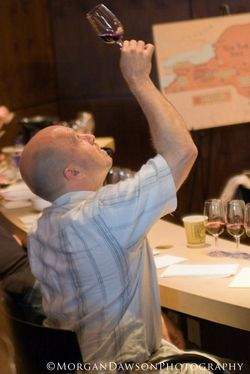













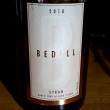
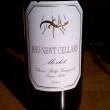


Evan,
Thanks for the report on what I’m sure was a killer tasting.
I’m curious about who the 42 people were, can you list them in a comment to the post? What about all of the wines?
Also, it seems a little weird to me to have Anthony Road’s cab franc-lemberger blend in the group. Especially if it’s a big chunk of Lemberger, which will change the character completely.
Curious to hear what participants thought of the tasting.
Lenn -
I’m running out the door and won’t be online until later, but I’ll list all of the wines tasted and all of the participants. I hope they’ll bring some lively discussion here.
It was my decision to include the AR Lemberger/Cab Franc because we’re now seeing more producers use that blend. I was curious to see if it stood out dramatically in a blind setting, and it didn’t, really. I loved it blind, gave it a high score. It was received quite well. But no one remarked that it was “probably not CF” or anything like that.
Evan,
Who picked the FL Cabernet Franc wines for this tasting? Why these FL wineries? Thank You. John Iszard
John,
The creator of this event, Neil Miller of the blog Stressing the Vine, came to me with a list. He asked me for my thoughts, and what began as a list of just about all Cab Franc makers had to be pared down to fit this tasting. Input came from me, Neil, and a few others, but ultimately the final list did not deviate much from Neil’s original intentions.
The goal was not to have a regional survey of essentially all producers — that’s just not possible, sadly.
Hi Evan,
Thank you for that nice report of what seems a wonderful tasting.
Would it be possible to release (privately and/or anonymized if deemed necessary) the full rankings made by the participants? That seems like quite a nice playground for any statistician and there might be some trends that might be extracted when drilling down on the data… We might even try to prove mathematically your instincts that you have had while looking at the results.
Julien,
While we do not want to go overboard with scores in this kind of event, I’d be happy to share them with you in a private email if you like. For what it’s worth, I asked each participate to indicate on their score sheets whether they were a W (for a wine industry professional), an R (for retailer), or an M (for media, meaning newspaper writer or blogger). When the event concluded I tallied not the only the overall scores, but I broke down the scores to see how each group ranked the wines. That’s how we discovered some disparities, which I found interesting.
If you’d like the complete list of scores, feel free to email me at epdaws@yahoo.com and I’ll be happy to send them along. Thanks!
Great recap!
Based on tasting NY, PA, and VA Cab Franc, I’d say that there is a *definite* regional difference that comes out in cooler climate CFs. After tasting CFs in CA last week, I’m beginning to wonder if they’re trying to make it taste like Cab Sauv out there…
Dude,
We considered adding a CA CF to the tasting, but we’re seriously talking apples and oranges there. Might have been interesting to note the contrast. Some CA producers are asking $60 or more for their CF, but much of what I’ve read indicates it’s a heavy, sweet, oaked style. Would you have been able to pick it out as CF in a blind tasting?
Hey Evan, We enjoyed the tasting, it re-affirmed our thoughts on how wines are judged.
Just have to call you on your comment and I quote
“Local winemakers do not seem to enjoy wines from
other regions” Perhaps you would like to see our recycling box, it’s up for viewing any Friday. In it you would find a wide variety of wines from all over the world. I think you would find this true of most of the winemakers in the Finger Lakes. If your basing your comment on the #5 in the first flight, I’ll be the first to say I love a little Brett in my wine, but that one was over the top.
Kate,
Thanks for the thoughts. I am not at all surprised to hear that you — or many others — enjoy wine from all over the world. That’s why I acknowledged my remark was probably a bit unfair. But it’s not simply based on one bretty wine! There is a community of wine professionals in the Finger Lakes that seeks out wine from across the globe, and I believe this makes them better winemakers and better tasters.
However, I’ve met more than a few who associate a foreign style with inferiority. I worry about that. So my remark is made in a general sense that I hope there isn’t a persistent regional palate that moves some people to think that outside wines are inherently inferior.
And while I enjoyed that Chinon — and especially the other Joguet Chinon that was poured at lunch! — I don’t deny it had brett. I guess that I’ve seen much worse and maybe I’m more willing to give it a pass as such!
I am very surprised that the Shinn Estate Vineyards 2007 fared so poorly at this tasting. At Taste Camp, nearly everyone, including myself, raved about this wine.
Did anyone make any specific comments about why they did not like the Shinn that much?
Richard,
First, to clarify, it finished 9th out of 16 wines, but in terms of points, it was only a few slots from the top quarter. That’s part of why I try not to go overboard on scores and numbers.
It was interesting; the people who liked the Shinn LOVED it. I had a handful of people approach me after the tasting to ask more about it. No surprise there. But it brought a different edge to the tasting, and again, I’m not sure some people welcome foreign wine profiles. Not that Shinn is from another planet; it certainly has some similarities with FLX, but it’s a bigger, richer style. Don’t know what else to say, but I’ll reiterate that I find the hype absolutely justified on this one.
Richard:
A lot can happen between the barrel and the bottle. Many winemakers, etc., swear by “bottle shock”. Makes sense to me that an extra dose of sulfites at bottling can turn the nose upside down, at least for a little while afterwards when the redox equilibrium comes back to normal. According to Evan, this stuff was bottled very recently.
For the record, I liked it at TasteCamp but wasn’t as gonzo for it as some of the others.
And, just to take the cynical view…
Some of the raving could be contagious, and some could be due to the entire experience at Shinn: touring the vineyard, hearing about biodynamics (and experiencing preparation 500 up close and personal), talking to the winemakers, etc. Not to mention a fantastic lunch!
Thanks Evan for the additional details. Thanks too to you Tom for your comments.
For me, I was initially more prepared not to like the Shinn Cab Franc as I usually am not a fan of that grape. Though I have been finding more and more that I do enjoy lately. I am thus unsure whether I would like the FL style of Cab Francs. It might possess more of that green/vegetal taste I dislike.
Richard - Vegetal green tends to be more dilute, under-ripe or over-cropped. That’s not the sole province of FL cab franc; it shows up wherever poor CF is made. Grilled herbs are a lovely component and far different, and when FL is right, you’ll get some of that mixed in with cracked black pepper and lush fruits.
Now, I’ve heard the folks from Shinn say that they seek to ripen and avoid just about any “green” flavors, as it can be marketing death, but I don’t wish to speak for them.
Evan,
I just wanted to congratulate you and the other organizers of the Cab. Franc tasting. I found this to be a particularly good format for tasting wines : ample time, nice glasses, clean and odor-free space. I believe this should be a format to pursue in the future.
As far as the wines are concerned, I took home both positive and negative impressions. Tasting through a line-up of Cab Franc without talking about bell pepper characteristics is encouraging. On a less positive note, too many of these wines showed clear signs of over-cropping resulting in a dilution of flavor intensity, lack of texture and overall neutral character. We should do better than this in a vintage such as 2007. I simply cannot agree with winemakers stating that 2007 was not a favorable vintage for cab franc. Overall, this was a very encouraging tasting and we should pursue this format with other grape varieties.
Well,
What to say? As Morten has observed the format of the tasting was exceptional. Time and opportunity. And with compelling examples from other regions. Focus and patience in tasting is everything.
Today I attended a ‘Red Pig’ (don’t ask) tasting and summer event. Many older and revered wines were offer up. ’59 German Rieslings, ’66 Bordeaux and so forth. What struck me about many of the wines was their freshness - the liveliness of the acidity in the wines. Much like red wines from the Finger Lakes. Such as Cabernet Franc. The tasting, for me, showed the freshness of the vintage, the mostly red fruit, and the delicate nature of Cabernet Franc. Very much like Pinot Noir, an aware and subtle hand is of great advantage in winegrowing Cab Franc. I for one look forward to more tastings such as this one.
Bob
Bob,
Thanks for the feedback. Your remarks remind me of a question that we’re hearing often in California: Is a big, rich, high-alcohol wine capable of aging? Certainly there are plenty of CA wines that are aging nicely, but I wonder if regions like the Finger Lakes are actually better equipped for making long-lived wines. Of course, that will only come about with a continued improvement and care in the vineyard.
The word “fresh” has a positive connotation for me, but I hope others don’t take it as a pejorative. Raciness is not reserved simply for white wines. It would be to the region’s advantage to make sure consumers understand the benefits of racy, fresh, complex red wines.
Aaww Kate. You’re rather strict on taste.
Hmm really lots of wine out there..
“656 Glasses of Wine”
Lots of wine glass and wine bottle..